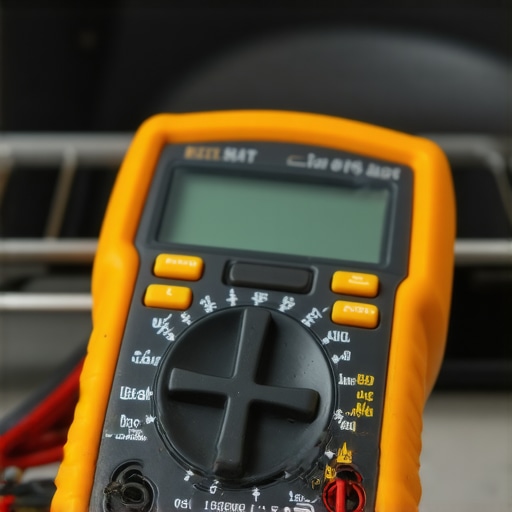My Unexpected Journey into Oven Troubleshooting
It all started on a chilly Saturday morning when my trusty oven decided to throw a tantrum right before I was about to bake a batch of cookies. Frustration quickly turned into curiosity, and I realized that understanding oven repair could save me both time and money. Over the years, I’ve learned that a little knowledge about diagnostics and key parts can make all the difference in restoring appliances efficiently.
Discovering the Secrets of Effective Oven Diagnostics
My first step was to dive into the basics of oven troubleshooting. I found that identifying the root cause often involves checking common issues like heating elements, thermostats, or faulty igniters. To get a clearer picture, I relied on reliable resources such as this comprehensive guide. It helped me develop a systematic approach, ensuring I didn’t miss crucial diagnostic steps, which is essential for quick and reliable fixes.
Key Parts That Keep Your Oven Running Smoothly
From my experience, certain parts tend to wear out over time and are often the culprits behind common oven problems. The heating element, temperature sensor, and oven control board are my go-to suspects. By understanding which parts are critical, I can better judge whether a replacement is needed or if a simple repair will suffice. For detailed insights on these components, I recommend checking out this detailed parts guide.
What’s the Real Deal with Diagnostic Accuracy?
Why is precise diagnostics so vital in oven repairs?
In my experience, accurate diagnostics save both time and money. Guesswork often leads to replacing parts unnecessarily, which can be costly and frustrating. A systematic diagnostic process ensures you target the exact issue, making repairs faster and more reliable. Moreover, it helps prevent further damage to your appliance, extending its lifespan. For a structured troubleshooting approach, I found this resource invaluable.
If you’re like me and want to keep your oven in top shape, I encourage you to share your own experiences or ask questions in the comments below. Sometimes, a small tip from a fellow DIY enthusiast can turn a frustrating repair into a simple fix!
Untangling the Complexities of Oven Diagnostics: An Expert’s Perspective
As seasoned DIY enthusiasts and appliance repair professionals know, diagnosing oven issues isn’t just about swapping out parts—it’s about understanding the nuanced interplay of components within the appliance. For instance, a faulty thermostat might mimic the symptoms of a malfunctioning heating element, leading to unnecessary replacements if not correctly identified. This is why a systematic, informed approach is crucial. For comprehensive diagnostic techniques, I highly recommend consulting this authoritative guide, which delves into the top strategies for accurate troubleshooting.
The Critical Role of Diagnostic Accuracy in Oven Repairs
What are the subtle signs that differentiate a faulty thermostat from a heating element issue?
Recognizing the subtle signs requires a keen eye and experience. A thermostat that is misreading temperature can cause the oven to cycle on and off irregularly, while a heating element may simply not heat at all. Using a multimeter to test these parts can provide definitive answers, but understanding the symptoms beforehand helps prioritize what to test. Accurate diagnostics prevent unnecessary part replacements, saving time and money, and extending the life of your oven. For targeted diagnostics, I suggest exploring this detailed parts guide.

Deep Dive into the Essential Oven Parts Every Technician Should Know
Beyond the obvious heating element and thermostat, there are less conspicuous yet equally vital parts such as the oven control board and temperature sensors. These components often escape casual inspection but are critical for proper oven function. A malfunctioning control board can lead to erratic operation or complete failure, while a defective sensor can result in inaccurate temperature readings. Gaining a deep understanding of these parts, including how to test and replace them, is fundamental for anyone serious about oven repair. For a thorough overview, check out this essential parts guide.
How Can Experts Ensure Precise Diagnostics for Long-Term Reliability?
Ensuring diagnostic precision involves a combination of proper testing tools, process discipline, and experience. Using a multimeter correctly, understanding the typical failure modes of parts, and following a structured troubleshooting flow are key. For example, verifying the integrity of the oven control board before replacing it can prevent unnecessary costs. Additionally, keeping abreast of the latest diagnostic tools and techniques through trusted resources enhances reliability. For practical insights, I recommend reviewing this troubleshooting resource.”
If you’re passionate about perfecting your repair skills, I invite you to share your experiences or ask questions in the comments. Sometimes, discussing a tricky diagnostic case can reveal new insights and solutions.
Beyond Basic Repairs: Embracing the Nuances of Oven Diagnostics
Over the years, my approach to oven troubleshooting has evolved from simple part replacements to a more nuanced understanding of the appliance’s intricate inner workings. Each repair taught me that recognizing subtle signs and understanding the interplay of components can make a significant difference. For instance, I once thought a malfunctioning thermostat was the sole culprit when, in reality, a faulty control board was causing erratic temperature readings. This experience pushed me to delve deeper into diagnostic strategies, realizing that an informed diagnosis prevents unnecessary part swaps and saves time.
Unraveling the Complexity of Oven Components
While heating elements and thermostats often steal the spotlight, I’ve learned that other parts like the oven control board and temperature sensors are equally vital. These components can silently fail, leading to issues that seem unrelated at first glance. Testing these parts requires patience and the right tools, such as a reliable multimeter. For example, a defective sensor might send incorrect signals, causing temperature inaccuracies that mimic heating element failures. Understanding the subtle differences in symptoms is crucial. For a thorough exploration of these parts, I recommend exploring this essential parts guide.
How Do I Pinpoint the Exact Fault? My Personal Diagnostic Approach
What advanced techniques can help differentiate between similar symptoms caused by different parts?
Diagnosing similar symptoms, like inconsistent heating, can be challenging. I’ve found that systematic testing—checking resistance with a multimeter, inspecting wiring connections, and verifying control signals—can clarify the root cause. For instance, when my oven cycled unpredictably, I initially suspected the thermostat. However, testing revealed a cracked solder joint on the control board, which was the real culprit. This reinforced my belief that a structured diagnostic process, guided by test results, is essential for accurate repairs. To refine your diagnostic skills, consider consulting this comprehensive troubleshooting guide.
Engaging with fellow DIY enthusiasts and sharing experiences has also enriched my understanding. If you’ve encountered similar issues or have tips, I invite you to share your stories or ask questions in the comments. Sometimes, a fresh perspective can reveal overlooked clues, turning a frustrating mystery into a straightforward fix.
The Subtle Art of Recognizing Diagnostic Clues
One aspect I’ve come to appreciate is the importance of paying attention to the smallest clues—like unusual noises, irregular cycling patterns, or inconsistent temperature readings. These subtle signs often point toward specific components. For example, a clicking relay might indicate relay failure, while uneven heating could signal sensor issues. Developing an intuitive sense for these clues takes experience, but it’s invaluable for efficient troubleshooting. For more advanced diagnostic insights, I suggest exploring this troubleshooting resource.
Deepening My Knowledge: Continuous Learning in Appliance Repair
Every repair challenge pushes me to learn more. I stay updated by reading technical manuals, participating in online forums, and experimenting with different tools. This ongoing education helps me refine my diagnostic techniques and avoid common pitfalls. For example, understanding the failure modes of the control board has saved me from unnecessary replacements, as sometimes a simple software reset or re-soldering can restore functionality. If you’re serious about mastering diagnostics, I highly recommend reviewing this expert guide.
If you’re passionate about improving your repair skills or have a unique diagnostic story, I’d love to hear your experiences. Sharing knowledge not only helps others but also deepens our collective understanding of these complex appliances.
Deciphering Complex Symptoms: When Standard Checks Fall Short
In my journey through professional appliance diagnostics, I’ve encountered numerous instances where conventional troubleshooting simply couldn’t unravel the root cause. For example, a seemingly straightforward heating failure might stem from a subtle solder joint crack on the control board, a detail that isn’t immediately apparent without meticulous inspection. Such complex cases demand a layered diagnostic approach, combining visual examination, advanced testing tools like oscilloscopes, and even software diagnostics when applicable. This level of analysis ensures that repairs are not just reactive but proactive, preventing future failures and extending the lifespan of your oven.
Harnessing the Power of Diagnostic Data: From Multimeters to Software Tools
While multimeters are fundamental, integrating software diagnostics and circuit analyzers can elevate your troubleshooting precision. Modern ovens equipped with smart controls often provide error codes or diagnostic modes accessible via their interfaces. Interpreting these signals requires familiarity with the manufacturer’s diagnostic protocols, which I delve into deeply in this authoritative guide. For instance, a persistent error code indicating sensor failure might actually be caused by a faulty control board sending incorrect signals. Recognizing such nuances prevents unnecessary part replacements, saving both time and money.
Why Advanced Diagnostics Are the Key to Long-Term Oven Performance
Adopting an advanced diagnostic mindset transforms oven repair from a hit-or-miss endeavor into a precise science. It enables the technician or DIY enthusiast to identify intermittent issues, subtle electrical anomalies, or software glitches that standard tests overlook. This approach not only ensures a durable fix but also enhances your understanding of the appliance’s intricate systems. If you’re eager to elevate your diagnostic skills, I encourage you to explore this comprehensive troubleshooting resource.
What are the latest diagnostic techniques that can uncover hidden faults in modern ovens?
Staying ahead in diagnostic techniques involves continuous learning and adopting innovative tools. Techniques such as thermal imaging cameras can reveal uneven heat distribution or hidden wiring faults, while firmware analysis can detect software anomalies causing erratic behavior. These methods demand an investment in specialized equipment but pay off by enabling pinpoint accuracy. For example, thermal imaging helped me identify a failing sensor wiring loom that was intermittently breaking contact, an issue invisible to the naked eye but critical for long-term reliability. Embracing such advanced methods can dramatically improve repair outcomes and appliance longevity.
If you’re passionate about refining your diagnostic expertise or have intriguing stories of complex repairs, I invite you to share your insights or ask questions below. Collaborating with a community of experienced repairers enriches our collective knowledge and sharpens our skills.
The Art of Fine-Tuning: Achieving Perfection in Oven Diagnostics
Over the years, I’ve realized that the difference between a good repair and a great one often lies in the finer details—such as verifying the integrity of solder joints, inspecting for micro-cracks in PCB traces, or cross-referencing error logs against known failure modes. These meticulous steps require patience and a methodical approach, but they are essential for diagnosing elusive faults. For example, a minor crack in a control board’s solder pad led to intermittent power issues that standard tests failed to detect. By honing my skills in microscopic inspection and circuit analysis, I can prevent future callbacks and ensure long-term appliance health.
Deepening Your Diagnostic Arsenal: Specialized Tools and Techniques
Beyond the basics, investing in specialized diagnostic tools like signal injectors, component testers, and firmware analyzers broadens your capabilities. These tools allow you to simulate operational conditions, test individual components in isolation, and even reprogram or reset control modules. For instance, I once used a firmware reflash tool to resolve a persistent software glitch that caused the oven to halt mid-cycle. Such expertise transforms troubleshooting from guesswork into a precise science, ensuring reliable, long-lasting repairs. For detailed guidance on these advanced techniques, I recommend reviewing this in-depth resource.
Engaging with these sophisticated diagnostics not only enhances your technical prowess but also builds confidence in handling complex appliance issues. If you’re committed to mastering these advanced methods, I encourage you to share your experiences or seek advice in the comments. Together, we can push the boundaries of DIY repair excellence and achieve unparalleled reliability in appliance maintenance.
Things I Wish I Knew Earlier (or You Might Find Surprising)
The Hidden Role of Wiring in Oven Troubleshooting
Early in my repair journey, I underestimated the importance of wiring and connections. A loose wire or a micro-crack in a solder joint can cause intermittent issues that seem baffling at first. Once I learned to inspect wiring harnesses thoroughly, troubleshooting became much more straightforward. It’s a reminder that sometimes, the simplest overlooked detail can be the key to a quick fix.
The Power of Visual Inspection Before Testing
Initially, I jumped straight into testing components with multimeters, but I realized that a careful visual inspection often reveals clues—like burnt spots, cracked boards, or corroded contacts—that direct my testing efforts more effectively. Patience in the inspection phase can save time and prevent unnecessary replacements.
Understanding Error Codes Can Save Your Day
Modern ovens with smart controls often display error codes that point directly to specific issues. I used to ignore these codes, but now I see them as invaluable diagnostic tools. Learning to interpret them correctly can drastically reduce guesswork and speed up repairs.
The Subtle Signs of Sensor Failures
Temperature sensors can fail gradually, causing inconsistent heating or inaccurate readings. Recognizing subtle signs like uneven temperature or delayed heating response helps me decide when to test or replace sensors, avoiding larger problems down the line.
The Importance of Patience and Systematic Testing
Rushing through diagnostics often leads to frustration. I’ve found that a methodical approach—testing one component at a time, recording findings, and cross-referencing symptoms—yields the best results. This discipline ensures long-term reliability and saves money.
Resources I’ve Come to Trust Over Time
- ApplianceBargainz.com: This site offers comprehensive guides on oven diagnostics and repair strategies. It’s my go-to resource for step-by-step troubleshooting tips that I’ve found reliable over the years.
- Manufacturer Service Manuals: Official manuals provide detailed schematics and error code explanations that are essential for precise diagnostics. I recommend them for anyone serious about repair.
- Online Forums and Communities: Places like Appliance Repair Forums are great for sharing experiences and learning from others’ real-world troubleshooting stories. They often reveal hidden issues and innovative solutions.
Parting Thoughts from My Perspective
Mastering oven diagnostics is a blend of patience, curiosity, and continuous learning. Over time, I’ve realized that paying close attention to the small details, leveraging trusted resources, and maintaining a systematic approach can turn a frustrating repair into a satisfying puzzle solved. If this resonates with you, I’d love to hear your thoughts or stories. Sharing our experiences not only builds confidence but also helps foster a community of skilled DIYers and professionals alike. Happy troubleshooting!

